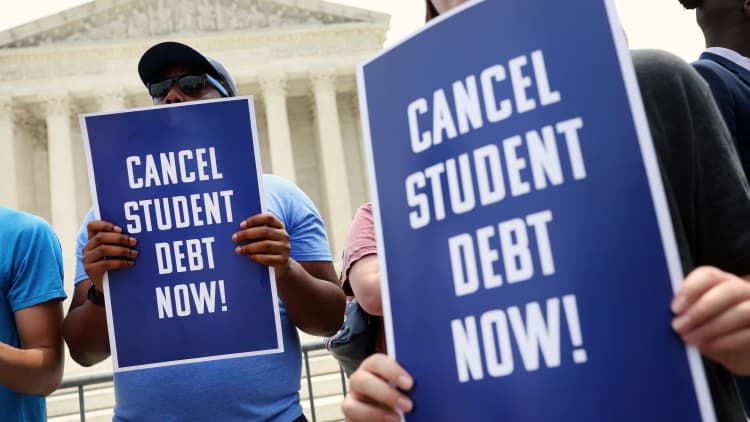Beginning in February, certain student loan borrowers who have spent a decade in repayment will get their federal student loan debt forgiven, the Biden administration recently announced.
Most borrowers need to make payments for 20 years or 25 years on an income-driven repayment plan before their debt is erased. But under the U.S. Department of Education's new repayment program, called the Saving on a Valuable Education, or SAVE, plan, those who took out $12,000 or less will get their debt erased after just a decade.
To qualify for the aid, you'll also need to make sure you have eligible federal student loans and that you're enrolled in the SAVE plan.
Here's what to know about the 10-year timeline to forgiveness.
Pandemic-era payment pause counts
The pandemic-era policy suspending federal student loan payments was an especially big win for borrowers enrolled in a program that concludes in debt forgiveness. That's because each month during the pause, which spanned more than three years, counts toward a borrowers' timeline, whether or not they made a payment.
It'll be no different with the SAVE plan, the Department of Education says.
More from Personal Finance:
IRS: Taxpayers may avoid a surprise tax bill with a quarterly payment by Jan. 16
Here are 3 ways Gen Zers can build credit before renting their own place
This beach city is helping older adults achieve their wish to age in place
As a result, those who qualify for the forgiveness after 10 years will have more than a third of their qualifying payments covered under the pause.
Other forbearances, deferments may count, too
The Department of Education gives federal student loan borrowers several options to pause their payments.
Due to the timeline of regulatory changes, borrowers may have to wait for some of these periods to be credited to their forgiveness timeline under the SAVE plan. Some of these stretches may only start counting after July.

But it seems that forbearances could qualify toward forgiveness: either 12 consecutive months in a forbearance, or 36 cumulative months, a Department of Education spokesperson told CNBC. Time spent in an economic hardship deferment, and other deferments, such as the deferments for cancer and unemployment, may also get you credit, depending on when you were enrolled.
You should also eventually get credit for time spent in repayment before a loan consolidation.
There may be an option to pay for forgiveness
The Department of Education added that borrowers, in time, can make "buyback" payments to get credit for any periods in deferments or forbearances that didn't count toward forgiveness.
But the spokesperson said that option hasn't been implemented yet. "We will provide more detail on it when it is going live," they said.
If your calculated payment under SAVE is currently $0, "the cost to the borrower for the buyback will be zero, letting them get all the other deferments and forbearances covered at no additional cost," said higher education expert Mark Kantrowitz. "It's a pretty sweet deal."
Don't miss these stories from CNBC PRO:
- Tesla versus BYD: Analysts prefer one of them — giving it up to over 70% upside
- Goldman says small caps to beat large caps this year. 10 cheap smaller stocks to buy
- DoubleLine's Gundlach sees 'very painful' economic downturn, S&P 500 may be forming 'double top'
- 'One of the best valuations for AI': Buy the dip in this Big Tech stock, strategist says


